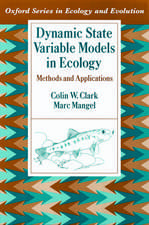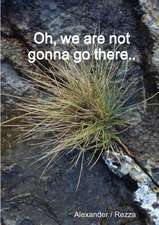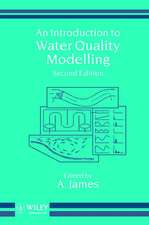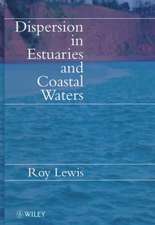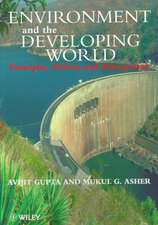Mathematical Bioeconomics – The Mathematics of Conservation 33: Pure and Applied Mathematics: A Wiley Series of Texts, Monographs and Tracts
Autor CW Clarken Limba Engleză Hardback – 17 iun 2010
Din seria Pure and Applied Mathematics: A Wiley Series of Texts, Monographs and Tracts
- 24%
 Preț: 621.47 lei
Preț: 621.47 lei - 9%
 Preț: 798.87 lei
Preț: 798.87 lei - 8%
 Preț: 594.34 lei
Preț: 594.34 lei - 9%
 Preț: 1114.77 lei
Preț: 1114.77 lei - 9%
 Preț: 829.41 lei
Preț: 829.41 lei - 9%
 Preț: 1209.93 lei
Preț: 1209.93 lei - 8%
 Preț: 617.99 lei
Preț: 617.99 lei - 9%
 Preț: 923.82 lei
Preț: 923.82 lei - 9%
 Preț: 857.34 lei
Preț: 857.34 lei - 9%
 Preț: 1165.76 lei
Preț: 1165.76 lei - 9%
 Preț: 1317.36 lei
Preț: 1317.36 lei - 9%
 Preț: 727.48 lei
Preț: 727.48 lei - 9%
 Preț: 1224.18 lei
Preț: 1224.18 lei - 9%
 Preț: 974.70 lei
Preț: 974.70 lei - 9%
 Preț: 1110.14 lei
Preț: 1110.14 lei - 9%
 Preț: 804.17 lei
Preț: 804.17 lei - 9%
 Preț: 1240.62 lei
Preț: 1240.62 lei - 9%
 Preț: 695.13 lei
Preț: 695.13 lei - 27%
 Preț: 732.36 lei
Preț: 732.36 lei - 9%
 Preț: 939.24 lei
Preț: 939.24 lei - 9%
 Preț: 1288.07 lei
Preț: 1288.07 lei - 9%
 Preț: 1413.59 lei
Preț: 1413.59 lei - 9%
 Preț: 925.07 lei
Preț: 925.07 lei - 9%
 Preț: 1285.43 lei
Preț: 1285.43 lei - 9%
 Preț: 1203.02 lei
Preț: 1203.02 lei - 9%
 Preț: 1324.39 lei
Preț: 1324.39 lei - 9%
 Preț: 1165.23 lei
Preț: 1165.23 lei - 9%
 Preț: 1210.47 lei
Preț: 1210.47 lei - 27%
 Preț: 876.60 lei
Preț: 876.60 lei - 9%
 Preț: 843.43 lei
Preț: 843.43 lei - 9%
 Preț: 1189.92 lei
Preț: 1189.92 lei - 9%
 Preț: 901.94 lei
Preț: 901.94 lei - 23%
 Preț: 676.42 lei
Preț: 676.42 lei - 8%
 Preț: 499.71 lei
Preț: 499.71 lei - 9%
 Preț: 1349.12 lei
Preț: 1349.12 lei -
 Preț: 418.61 lei
Preț: 418.61 lei - 9%
 Preț: 1117.90 lei
Preț: 1117.90 lei - 8%
 Preț: 635.83 lei
Preț: 635.83 lei - 9%
 Preț: 1225.07 lei
Preț: 1225.07 lei - 9%
 Preț: 1912.96 lei
Preț: 1912.96 lei - 27%
 Preț: 959.22 lei
Preț: 959.22 lei -
 Preț: 300.05 lei
Preț: 300.05 lei - 9%
 Preț: 1262.58 lei
Preț: 1262.58 lei -
 Preț: 272.94 lei
Preț: 272.94 lei - 9%
 Preț: 1151.19 lei
Preț: 1151.19 lei - 9%
 Preț: 1066.30 lei
Preț: 1066.30 lei - 9%
 Preț: 891.49 lei
Preț: 891.49 lei - 31%
 Preț: 1036.69 lei
Preț: 1036.69 lei - 31%
 Preț: 820.09 lei
Preț: 820.09 lei
Preț: 766.69 lei
Preț vechi: 842.52 lei
-9% Nou
Puncte Express: 1150
Preț estimativ în valută:
146.73€ • 152.62$ • 121.13£
146.73€ • 152.62$ • 121.13£
Carte tipărită la comandă
Livrare economică 12-26 aprilie
Preluare comenzi: 021 569.72.76
Specificații
ISBN-13: 9780470372999
ISBN-10: 0470372990
Pagini: 392
Dimensiuni: 156 x 234 x 22 mm
Greutate: 0.68 kg
Ediția:3rd Edition
Editura: Wiley
Seria Pure and Applied Mathematics: A Wiley Series of Texts, Monographs and Tracts
Locul publicării:Hoboken, United States
ISBN-10: 0470372990
Pagini: 392
Dimensiuni: 156 x 234 x 22 mm
Greutate: 0.68 kg
Ediția:3rd Edition
Editura: Wiley
Seria Pure and Applied Mathematics: A Wiley Series of Texts, Monographs and Tracts
Locul publicării:Hoboken, United States
Public țintă
Resource managers, conservation biologists, ecologists, applied mathematicians, biologists, and scientists at fisheries and wildlife agencies; also appropriate for economic analysts and consultants as well as ecological, environmental, and resource economists; upper–undergraduate and graduate level students in optimization and modeling in applied mathematics; and academic libraries.Notă biografică
Cuprins
Descriere
Mathematical Bioeconomics: The Mathematics of Conservation analyzes the economic forces underlying the misuse of biological renewable resources and discusses economically effective methods of resource management. It shows how rigorous mathematical modeling can be used to solve the complex problems of bioeconomics.


